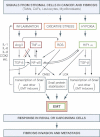Inflammation and EMT: an alliance towards organ fibrosis and cancer progression
- PMID: 20049734
- PMCID: PMC3378143
- DOI: 10.1002/emmm.200900043
Inflammation and EMT: an alliance towards organ fibrosis and cancer progression
Abstract
Recent advances in our understanding of the molecular pathways that govern the association of inflammation with organ fibrosis and cancer point to the epithelial to mesenchymal transition (EMT) as the common link in the progression of these devastating diseases. The EMT is a crucial process in the development of different tissues in the embryo and its reactivation in the adult may be regarded as a physiological attempt to control inflammatory responses and to 'heal' damaged tissue. However, in pathological contexts such as in tumours or during the development of organ fibrosis, this healing response adopts a sinister nature, steering these diseases towards metastasis and organ failure. Importantly, the chronic inflammatory microenvironment common to fibrotic and cancer cells emerges as a decisive factor in the induction of the pathological EMT.
Figures

Betty Hay coined the term ‘epithelial to mesenchymal transformation’ (Hay, 1968) and described the transient nature of this process, as well as the reversion to the epithelial character (MET, Hay, 1991). Modified from Acloque et al (2008).
More than 100 years ago Santiago Ramón y Cajal drew and described the morphological appearance of breast carcinoma so accurately that we can find what we believe to be the first description of EMT (see text). Drawings are adapted from figs. 53 and 48 in Ramon y Cajal (1890). Note the morphology of the cell highlighted as ‘b’.
At the turn of the 20th century, Hugo Apolant also clearly represented the morphology of EMT-type mouse mammary tumours (Apolant, 1906). The micrograph shows the distribution of cytokeratin 8/18 in both the epithelial and spindle cell populations in a mouse mammary tumour diagnosed as EMT-type. This picture is courtesy of Dr P. Damonte and Dr R. Cardiff, Univ. California at Davis.

Immunohistochemical staining of a colorectal carcinoma for β-catenin in red and nuclear counterstaining in blue. The central area of the tumour exhibits polarized epithelial tumour cells lacking nuclear β-catenin, while cells at the invasive front undergo EMT and show nuclear β-catenin (Brabletz et al, 2001). Picture from Dr Thomas Brabletz, Univ. Freiburg (Germany).
Histological sections showing the halmarks of EMT in the medulla of fibrotic kidney from patients subjected to nephrectomy. Sections are stained with haematoxylin–eosin (H/E) to better appreciate cell morphology and the disappearance of the tubular structures in fibrosis, vimentin expression showing mesenchymal cells (brown, Vim) and fibrotic deposits revealed by the blue Masson–Trichome staining (M/T) (Boutet et al, 2006).

Similar articles
-
Organ Fibrosis and Autoimmunity: The Role of Inflammation in TGFβ-Dependent EMT.Biomolecules. 2021 Feb 18;11(2):310. doi: 10.3390/biom11020310. Biomolecules. 2021. PMID: 33670735 Free PMC article. Review.
-
EMT: a new vision of hypoxia promoting cancer progression.Cancer Biol Ther. 2011 Apr 15;11(8):714-23. doi: 10.4161/cbt.11.8.15274. Epub 2011 Apr 15. Cancer Biol Ther. 2011. PMID: 21389772 Review.
-
TGF-β1 - A truly transforming growth factor in fibrosis and immunity.Semin Cell Dev Biol. 2020 May;101:123-139. doi: 10.1016/j.semcdb.2019.12.010. Epub 2019 Dec 24. Semin Cell Dev Biol. 2020. PMID: 31879265 Review.
-
The role of the epithelial-to-mesenchymal transition (EMT) in diseases of the salivary glands.Histochem Cell Biol. 2018 Aug;150(2):133-147. doi: 10.1007/s00418-018-1680-y. Epub 2018 May 23. Histochem Cell Biol. 2018. PMID: 29789993 Review.
-
Metformin against TGFβ-induced epithelial-to-mesenchymal transition (EMT): from cancer stem cells to aging-associated fibrosis.Cell Cycle. 2010 Nov 15;9(22):4461-8. doi: 10.4161/cc.9.22.14048. Epub 2010 Nov 15. Cell Cycle. 2010. PMID: 21088486
Cited by
-
Microparticles derived from human erythropoietin mRNA-transfected mesenchymal stem cells inhibit epithelial-to-mesenchymal transition and ameliorate renal interstitial fibrosis.Stem Cell Res Ther. 2020 Sep 29;11(1):422. doi: 10.1186/s13287-020-01932-z. Stem Cell Res Ther. 2020. PMID: 32993806 Free PMC article.
-
The role of the ZEB1-neuroinflammation axis in CNS disorders.J Neuroinflammation. 2022 Nov 19;19(1):275. doi: 10.1186/s12974-022-02636-2. J Neuroinflammation. 2022. PMID: 36402997 Free PMC article. Review.
-
Analyzing small RNA sequences from canine stem cell-derived extracellular vesicles primed with TNF-α and IFN-γ and exploring their potential in lung repair.Front Vet Sci. 2024 Jul 1;11:1411886. doi: 10.3389/fvets.2024.1411886. eCollection 2024. Front Vet Sci. 2024. PMID: 39011319 Free PMC article.
-
Tumor cell dissemination: emerging biological insights from animal models and cancer patients.Cancer Cell. 2013 May 13;23(5):573-81. doi: 10.1016/j.ccr.2013.04.017. Cancer Cell. 2013. PMID: 23680145 Free PMC article. Review.
-
CircACTR2 in macrophages promotes renal fibrosis by activating macrophage inflammation and epithelial-mesenchymal transition of renal tubular epithelial cells.Cell Mol Life Sci. 2022 Apr 21;79(5):253. doi: 10.1007/s00018-022-04247-9. Cell Mol Life Sci. 2022. PMID: 35449370 Free PMC article.
References
-
- Adorno M, Cordenonsi M, Montagner M, Dupont S, Wong C, Hann B, Solari A, Bobisse S, Rondina MB, Guzzardo V, et al. A mutnat-p53/Smad complex opposes p63 to empower TGFβ-induced metastasis. Cell. 2009;177:87–98. - PubMed
-
- Apolant H. Die epithelialen Geschwülste der Maus. Arb Königl Inst Exp Ther. 1906;1:7–62.
-
- Baan C, van Gelder T, Peeters A, Mol W, Niesters H, Weimar W, IJzermans J. Living kidney donors and hypoxia-inducible factor-1alpha. Transplantation. 2003;75:570–571. - PubMed
Publication types
MeSH terms
Substances
LinkOut - more resources
Full Text Sources
Other Literature Sources

